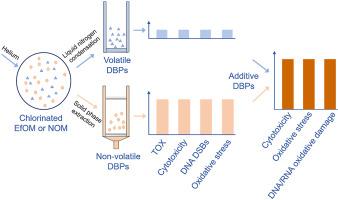Water Research ( IF 11.4 ) Pub Date : 2020-06-18 , DOI: 10.1016/j.watres.2020.116080 Qian-Yuan Wu 1 , Zi-Fan Liang 1 , Wen-Long Wang 2 , Ye Du 3 , Hong-Ying Hu 4 , Lu-Lin Yang 1 , Wen-Cheng Huang 5

|
Water is often chlorinated to protect public health, but chlorination causes harmful disinfection byproducts to form. Currently available in vitro assays generally determine non-volatile disinfection byproduct (NVDBP) toxicities because of the limitation of pretreatments used, but chemical analyses and regulations are focused on volatile disinfection byproducts (VDBPs) such as trihalomethanes. The gap of VDBP toxicities have been of concern for some time. In this study, we extracted VDBPs from two chlorinated effluent organic matters and one chlorinated natural organic matter, using a helium aeration–liquid nitrogen condensation system, and systematically assessed the VDBP and NVDBP toxicities to mammalian cells. VDBPs accounted for 10%–20% of the total organic halogen concentrations in three chlorinated water samples. VDBPs were much less cytotoxic, caused fewer DNA double-strand breaks, induced less reactive oxygen species and DNA/RNA oxidative damage marker of 8-hydroxyl(deoxy)guanosine in cells than did NVDBPs. Moreover, by collecting the VDBPs, toxicity measurement of the full range of DBPs was achieved. Cytotoxicity, reactive oxygen species and 8-hydroxyl(deoxy)guanosine levels were significantly higher for cells exposed to the mixture of VDBPs and NVDBPs than only NVDBPs, but not by large percentages (20%–30% for cytotoxicity), suggesting NVDBPs mainly contributed to the toxicity of chlorinated water. Our study suggested that future research should focus more on NVDBP toxicity and identifying toxicity drivers from NVDBPs.
中文翻译:

非挥发性消毒副产物对哺乳动物细胞的毒性远大于挥发性副产物。
为了保护公众健康,经常对水进行氯化处理,但是氯化处理会形成有害的消毒副产物。目前在体外可用由于所使用的预处理方法的局限性,化验通常确定非挥发性消毒副产物(NVDBP)的毒性,但是化学分析和法规侧重于挥发性消毒副产物(VDBP),例如三卤甲烷。VDBP毒性的差距已引起人们关注。在这项研究中,我们使用氦气-液氮冷凝系统从两种氯化废水有机物和一种氯化天然有机物中提取了VDBP,并系统评估了VDBP和NVDBP对哺乳动物细胞的毒性。在三个氯化水样品中,VDBP占总有机卤素浓度的10%至20%。VDBP的细胞毒性小得多,引起的DNA双链断裂更少,与NVDBPs相比,诱导的细胞中8-羟基(脱氧)鸟苷的活性氧种类和DNA / RNA氧化损伤标记物少。此外,通过收集VDBP,可以测量所有DBP的毒性。暴露于VDBP和NVDBP混合物的细胞的细胞毒性,活性氧和8-羟基(脱氧)鸟苷水平显着高于仅NVDBP,但比例却不高(细胞毒性为20%–30%),这表明NVDBP的主要贡献对氯化水的毒性。我们的研究表明,未来的研究应更多地关注NVDBP毒性并从NVDBPs中识别毒性驱动因素。暴露于VDBP和NVDBP混合物的细胞的活性氧和8-羟基(脱氧)鸟苷水平显着高于仅NVDBP,但比例却不高(细胞毒性为20%–30%),这表明NVDBP主要是导致氯化水的毒性。我们的研究表明,未来的研究应更多地关注NVDBP毒性,并从NVDBPs中识别毒性驱动因素。暴露于VDBP和NVDBP混合物的细胞的活性氧和8-羟基(脱氧)鸟苷水平显着高于仅NVDBP,但比例却不高(细胞毒性为20%–30%),这表明NVDBP主要是导致氯化水的毒性。我们的研究表明,未来的研究应更多地关注NVDBP毒性并从NVDBPs中识别毒性驱动因素。











































 京公网安备 11010802027423号
京公网安备 11010802027423号